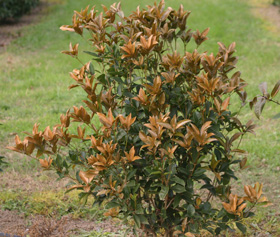Home > Health and maintenance > Solve problems > Brown leaves > Cold damage
Cold damage
 Foliage, twigs, major branches and even the trunk can be damaged or killed on a cold night. This can occur even on shrubs and trees that are considered hardy in the region. Pictured here is a holly damaged on a cold spring night after new foliage emerged.
Foliage, twigs, major branches and even the trunk can be damaged or killed on a cold night. This can occur even on shrubs and trees that are considered hardy in the region. Pictured here is a holly damaged on a cold spring night after new foliage emerged.
A peak at the USDA 1990 cold hardiness map shows that the winter of January through March 2012 brought a normal low temperature range to much of Florida and the rest of the country. This appeared to catch some people by surprise. Several situations lead to cold damaged trees and shrubs.
First, for about 15 years, we have been planting trees and shrubs perhaps better suited for parts south of us. However, we all like to “push” a plant a bit farther north than recommended based on long term climate data. Trees and shrubs better suited for hardiness zone 10 have been planted, sometimes routinely, well up into zone 9. Some zone 9 plants have been planted in zones 8 or even farther north.
Another cause of plant damage in winter 2010 was the extended period of cold weather. Few horticulturists can remember cold temperatures lasting for almost two weeks straight as occurred in winter 2010. This extended cold snap caused much of the damage.
 Symptoms: Cold damage symptoms include dead, sunken, cracked, or dark patches on the trunk. Bark often flakes off. Damage may be more prevalent on younger and smaller diameter twigs and branches. Cankers may form on the trunk or branches caused by Hypoxylon and other fungi. Root pathogens such as Armillaria and others can cause root decline on weakened trees. Borers, beetles and other stress related insects may also cause infestations on weakened trees. Many damaged trees and shrubs display dead tops as shown in the nearby photo. Plants often sprout from internal portions of branches. Some sprouts might grow from branches with cracked bark. Severely damaged plants might also form sprouts along the trunk.
Symptoms: Cold damage symptoms include dead, sunken, cracked, or dark patches on the trunk. Bark often flakes off. Damage may be more prevalent on younger and smaller diameter twigs and branches. Cankers may form on the trunk or branches caused by Hypoxylon and other fungi. Root pathogens such as Armillaria and others can cause root decline on weakened trees. Borers, beetles and other stress related insects may also cause infestations on weakened trees. Many damaged trees and shrubs display dead tops as shown in the nearby photo. Plants often sprout from internal portions of branches. Some sprouts might grow from branches with cracked bark. Severely damaged plants might also form sprouts along the trunk.
Treatments: Keep root zone moist in the year after the cold snap to promote root growth. No special fertilizer is necessary. Preventive applications for borer control could be indicated for valuable plants. Dead branches can be pruned cleanly back to the most distal sprouts any time following the damage. Allow the tree or shrub to grow on its own so it can rebuild its energy (starch) supply. This is accomplished by retaining all live foliage generated in the growing season following the damage (in this case, summer and fall 2010). Restoration pruning can begin the next dormant season 2011.See detailed information about restoration pruning.

